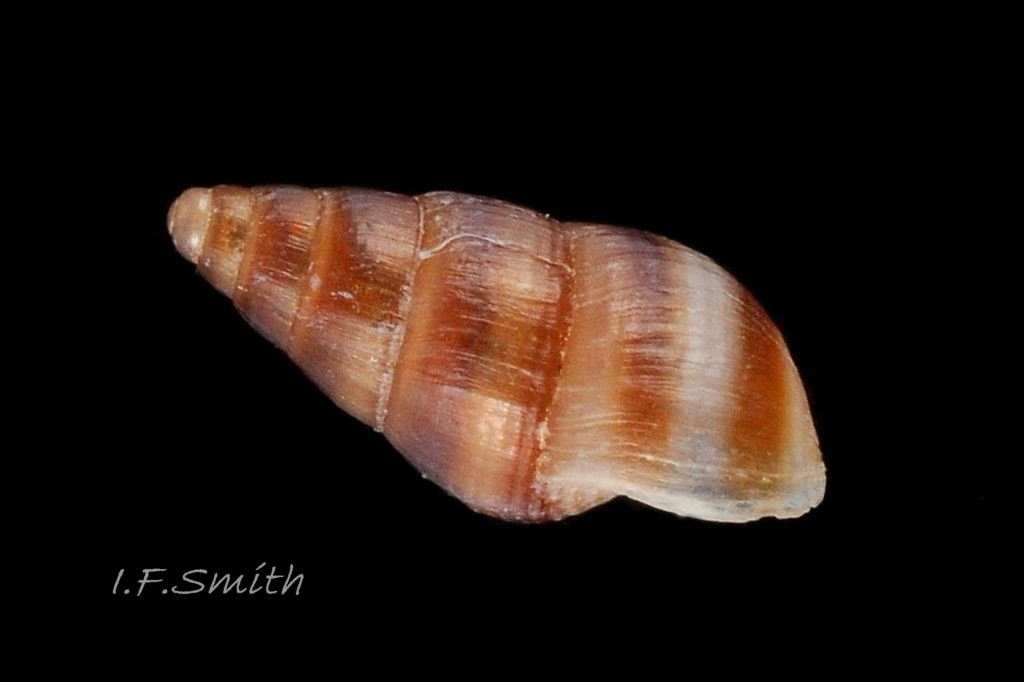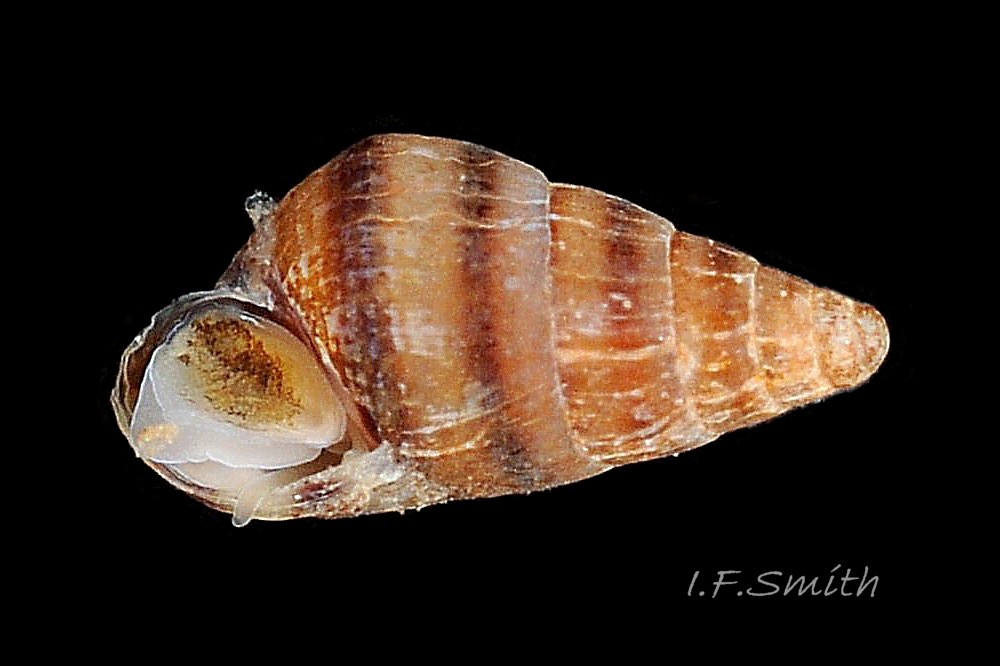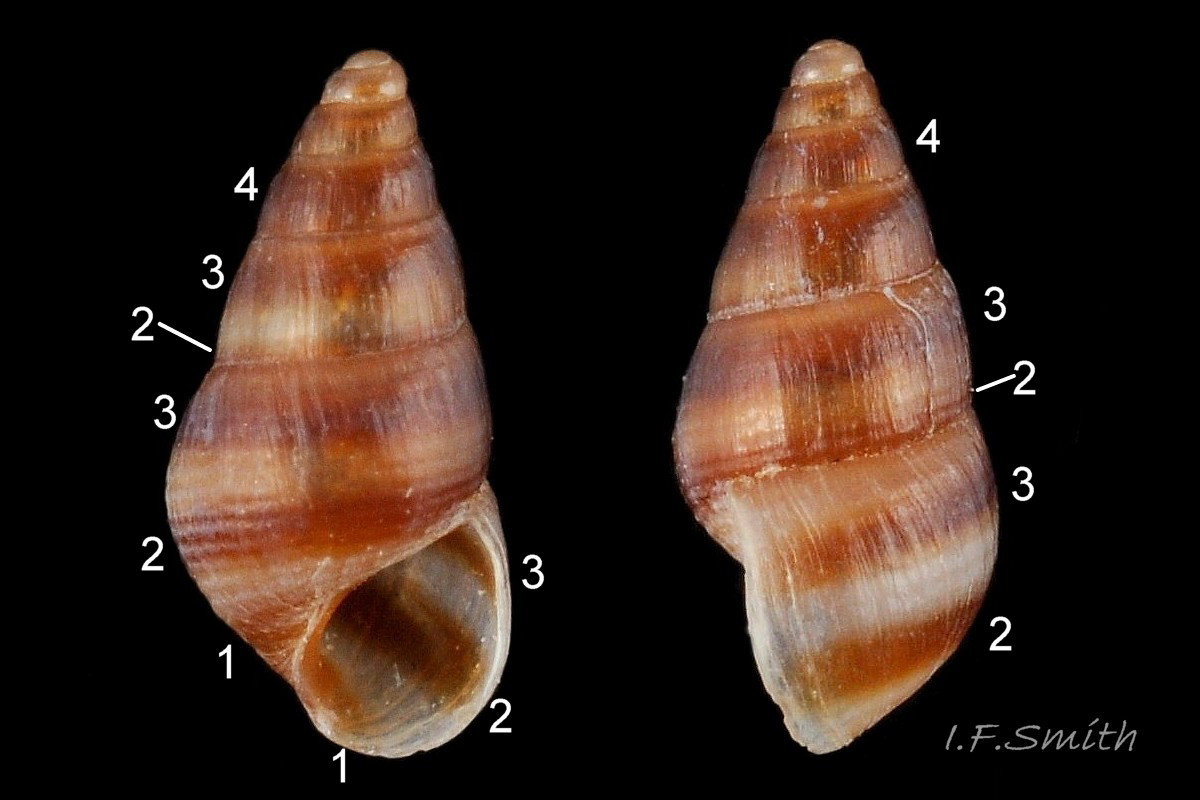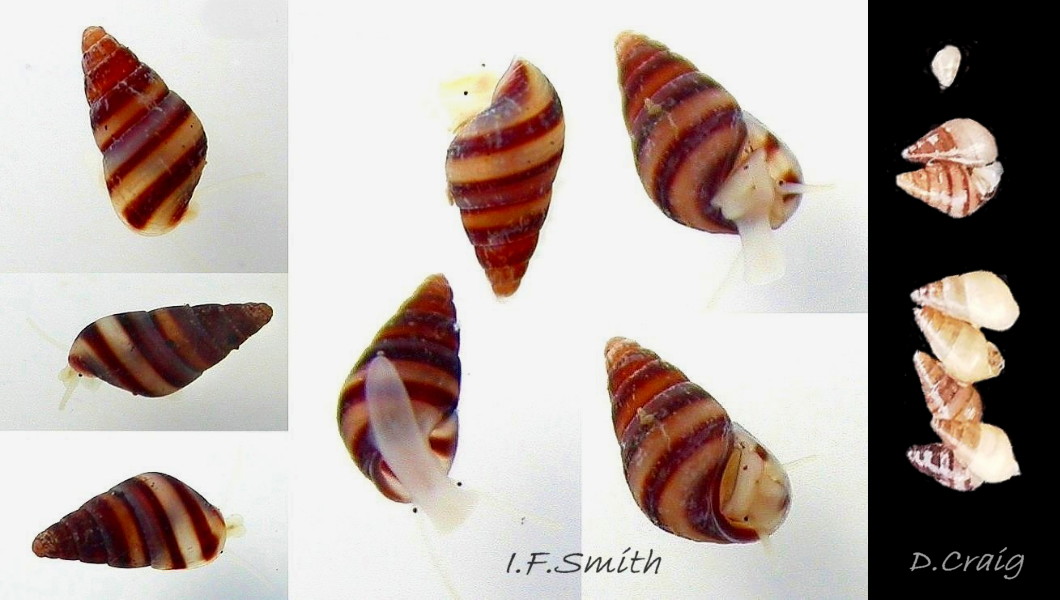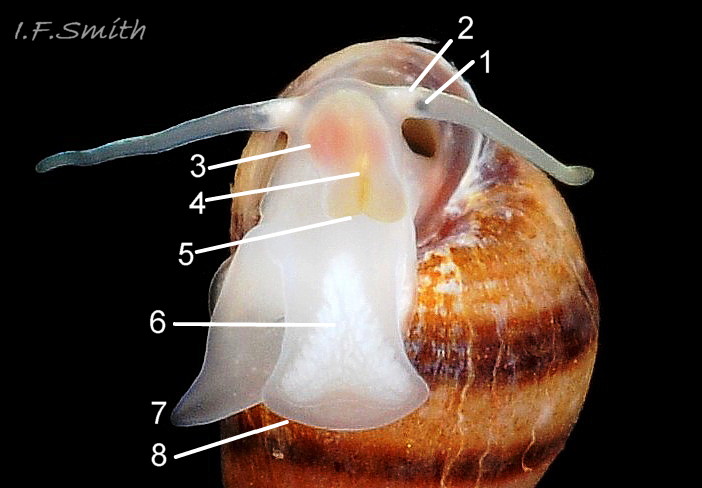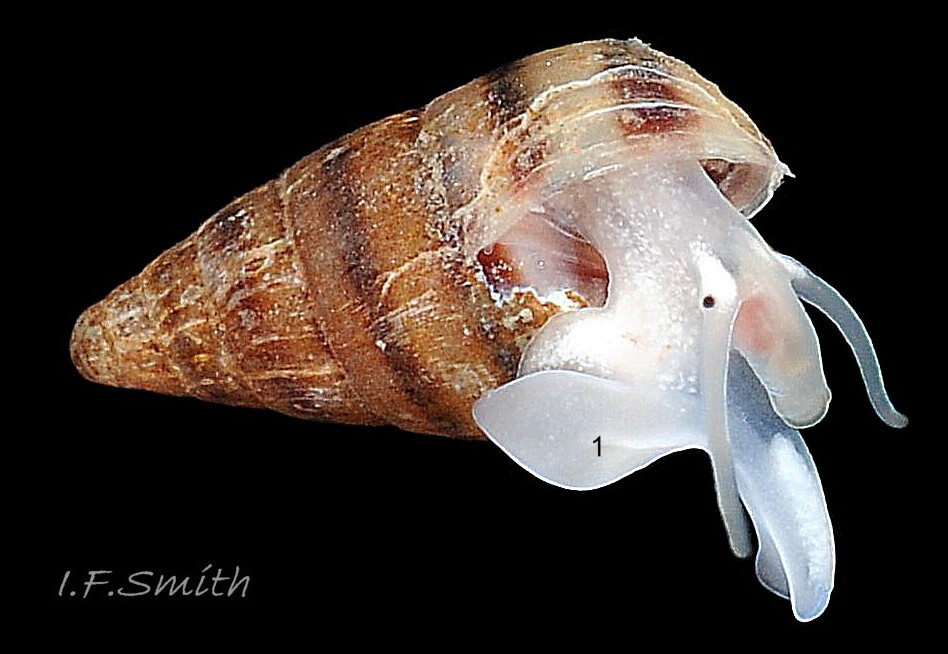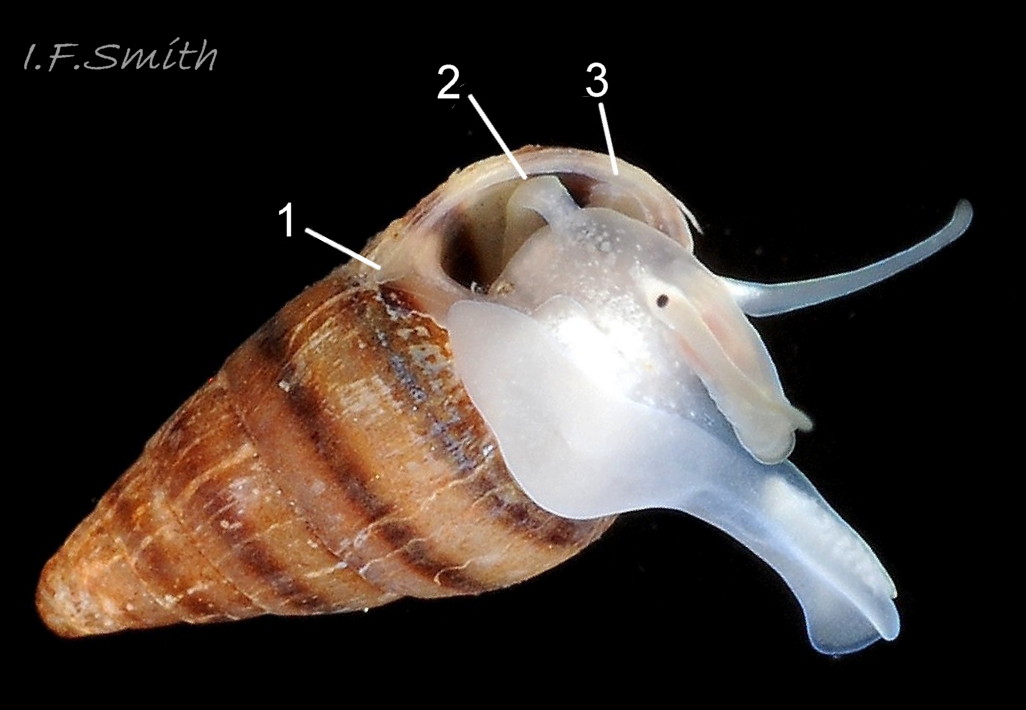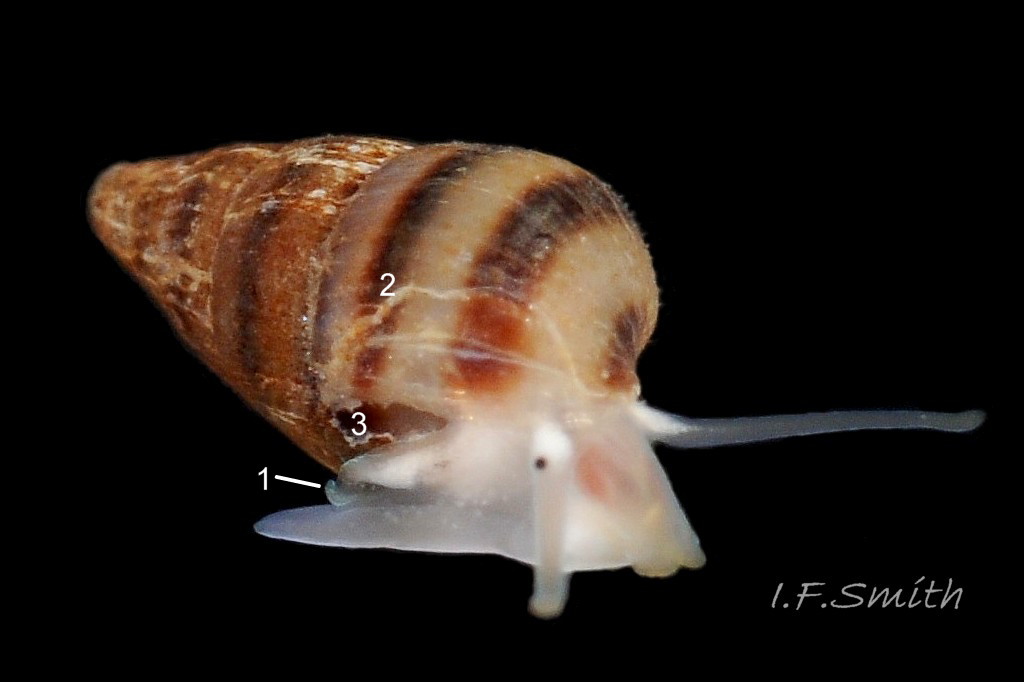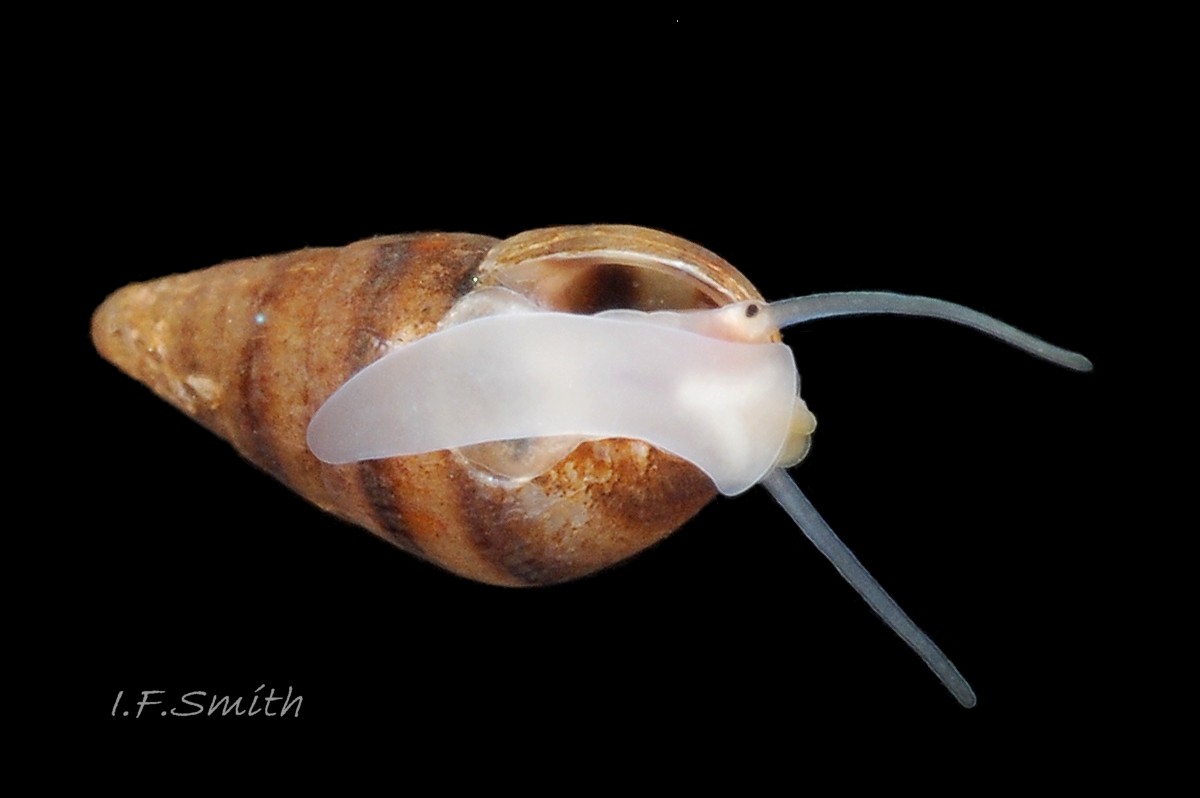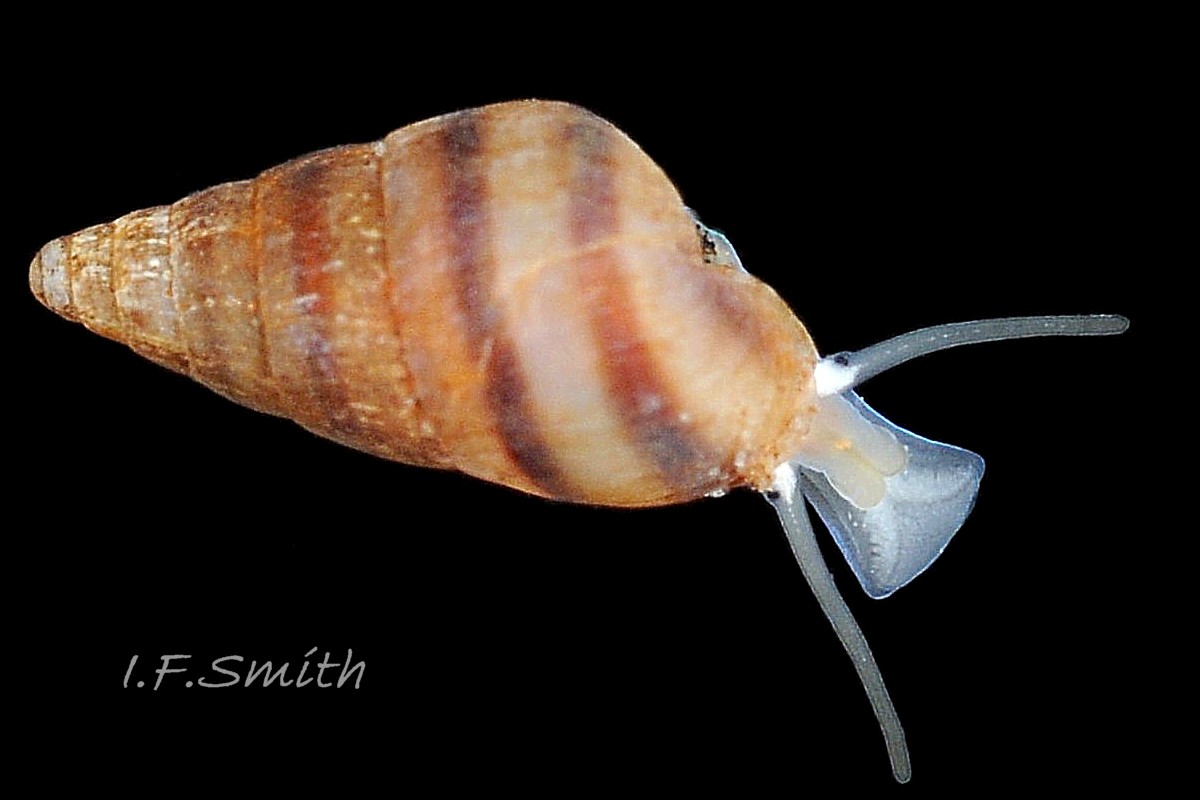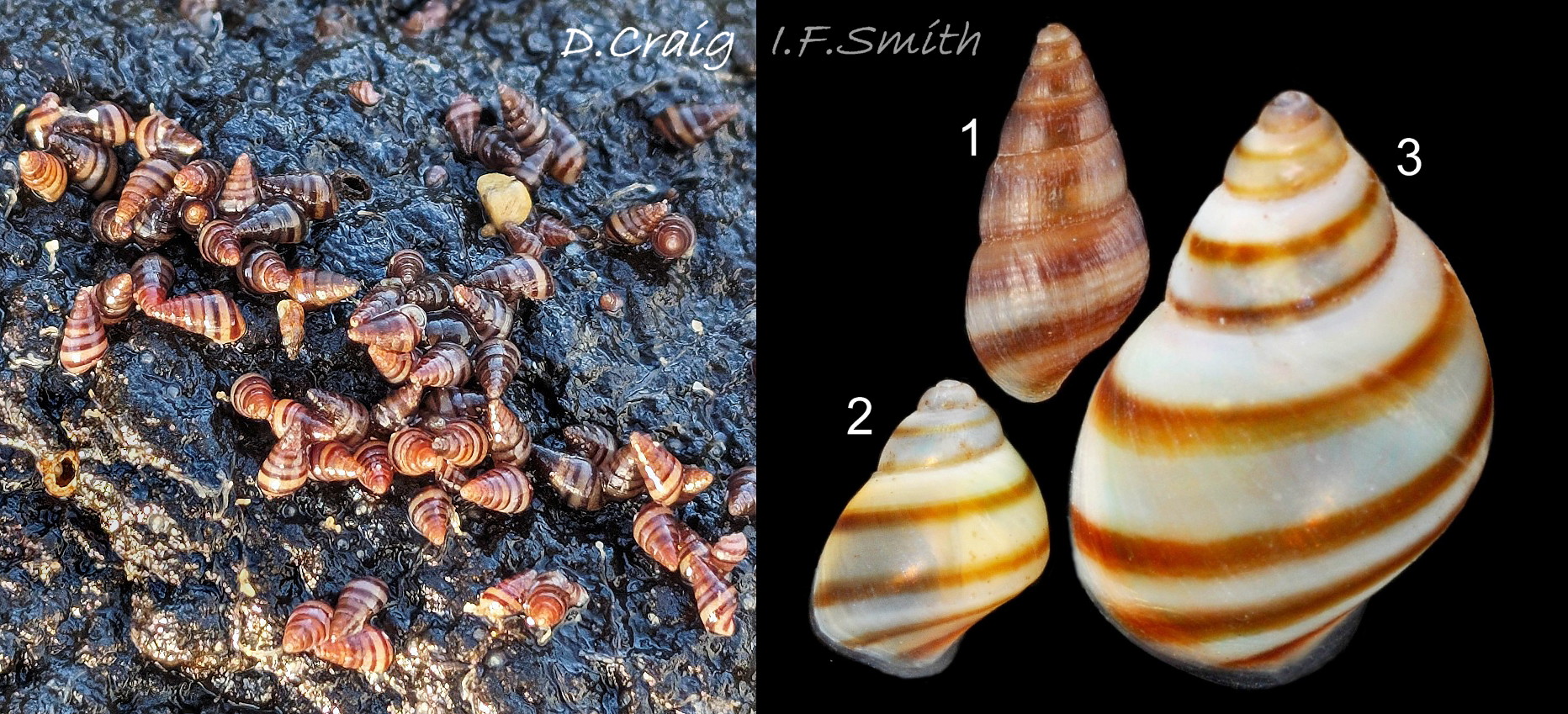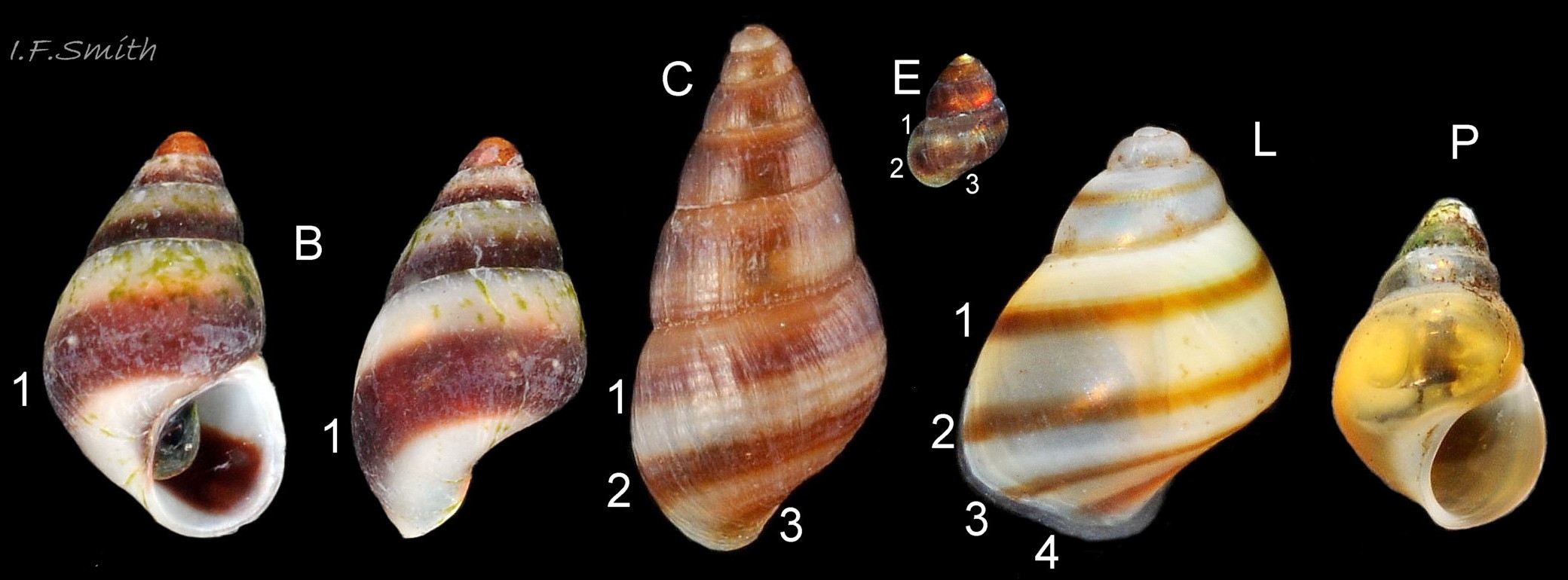Click image to enlarge with full caption. Main text below slider.
Cingula trifasciata ( J. Adams, 1800)
Synonyms: Turbo trifasciatus J.Adams, 1800; Rissoa cingillus (Montagu, 1803); Turbo vittatus Donovan; Cingula cingillus (Montagu, 1803);
Current taxonomy: World Register of Marine Species www.marinespecies.org/aphia.php?p=taxdetails&id=141268
GLOSSARY below.
Shell Description
Usually up to 4 mm high, exceptionally 4.3 mm. Solid, long, gradually tapering, conical spire with small blunt apex. Body whorl, about 60% of shell height, subangulated at start of basal slope. Spire-whorls only slightly rounded, so almost straight-sided profile 01 Cingula trifasciata. Sutures distinct. Superficially smooth, but fine ornament (best seen under magnification on dead dry shells) of spiral striae on base of body whorl, crowded fine transverse striae and irregular transverse coarser lines 02 Cingula trifasciata & 10 Cingula trifasciata. No umbilicus 03 Cingula trifasciata. Aperture oval coming to acute adapical point; about 40% of shell height 01 Cingula trifasciata. Aperture lips of adults thickened and slightly everted basally. Operculum oval, eccentric spiral 04 Cingula trifasciata. Ground colour of shell varies buff to yellowish-brown; often brownish-white on body whorl.
Body whorl has three spiral brown bands 05 Cingula trifasciata.
1) incomplete band near columella
2) complete band near periphery,
3) complete band between band 2 and suture .
Spire whorls have continuation of band 3 and, usually, continuation of upper edge of band 2 as thin, often indistinct, line by abapical suture . Markings less clear on small whorls near apex. Brown of bands varies chocolate-brown to red-brown 06 Cingula trifasciata. Occasionally, bands merge to form entirely brown shell. Unbanded variety C.t. rupestris entirely cream or white. Periostracum colourless or pale horn, transparent, gives resinous lustre to shell.
Body Description
Flesh translucent white with opaque white marks. Internal pink buccal mass and yellow oral tube show through semi-transparent, yellowish-white, bifid snout 07 Cingula trifasciata. Translucent cephalic tentacles are long, cylindrical, slender, blunt tipped, with conspicuous black eye on bulge at posterior of base 08 Cingula trifasciata. Small pallial tentacle in adapical angle of aperture when animal extended 09 Cingula trifasciata. When animal crawling, yellowish translucent operculum rests on white opercular lobe 03 Cingula trifasciata , and metapodial tentacle extends from rear of opercular lobe 10 Cingula trifasciata. Large penis on dorsum behind male’s head curves back into mantle cavity when not in use 09 Cingula trifasciata. White ctenidium with as few as six large filaments 09 Cingula trifasciata.
Foot narrow, widest at curved anterior 11 Cingula trifasciata, often axe head shaped 12 Cingula trifasciata; posterior bluntly pointed. Foot anterior bilaminate 09 Cingula trifasciata; upper layer (anterior pedal gland producing mucus to aid locomotion) with widely forked anterior, less extensive than lower layer 12 Cingula trifasciata. Sole has posterior pedal gland and groove for secretion that hardens into adhesive thread used for securing animal against dislodgement and for crawling up and down from water surface 08 Cingula trifasciata. Translucent white flesh has opaque-white freckles on sides of body and upper surface of rear half of foot, opaque-white patch behind eye 08 Cingula trifasciata and large opaque-white triangle with concave sides on anterior pedal gland 07 Cingula trifasciata.
Key identification features
Cingula trifasciata
1) Height of shell less than 4.3 mm.
2) Solid, long, conical spire with almost straight sided profile 14 Cingula trifasciata .
3) No umbilicus or chink. 03 Cingula trifasciata.
4) Usually three brown or red-brown spiral bands on body whorl 05 Cingula trifasciata (one at columella an incomplete turn 03 Cingula trifasciata.
5) In crevices or under stones with silt, not on algae. Gregarious, all sizes found together. Often near high water mark, but all other levels also, including pools near LWS.
Similar species
Lacuna vincta (Montagu, 1803)
1) Adults (die after spawning in spring) up to 10 mm high.
2) Well developed adult spire, but whorls always more rounded than on C. trifasciata 13 Cingula trifasciata . Juveniles of 4 mm and less are much more globose than C. trifasciata 14 Cingula trifasciata . In summer all surviving L. vincta are small juveniles.
3) Columella has long groove (“chink”) leading to umbilicus.
4) Usually four orange-brown spiral bands on body whorl, but sometimes merged.
5) Often in large numbers in N. Britain, but annual so rarely find adults (winter/spring) and juveniles (summer) together. On algae, especially Laminaria, not under stones or in crevices. Confined to LWS and below.
Eatonina fulgida (J. Adams, 1797) 14 Cingula trifasciata
1) Adults 1 mm or less high.
2) Small spire with well rounded whorls and deep sutures.
3) Distinct umbilicus.
4) Three brown spiral bands, often merged, on body whorl, (one of them partial; only by columella).
5) In silt and on algae at bottom of rock pools near LWS. Can be abundant in suitable conditions.
Barleeia unifasciata (Montagu, 1803) 14 Cingula trifasciata
1) Maximum shell height usually 2.5 mm.
2) Rather squat, solid, opaque shell. Has unique, in Britain, flexed, black-crimson operculum with silvery refringence.
3) No umbilicus, except on very young juveniles.
4) Spire-whorls of banded forms have a broad brownish-red abapical band; body-whorl occasionally has more brown bands.
5) On small red algae, such as Chondrus and Gelidium, growing as a turf on sheltered rocky shores near LWS, especially in pools
Peringia ulvae (Pennant, 1777)
1) Maximum shell-height usually 6 mm, exceptionally 10 mm.
2) Spire 50% of shell height when 2.5 mm high 14 Cingula trifasciata ; 65% when 6.5 mm high.
3) No umbilicus,
4) No brown bands on shell.
5) On mud or muddy sand especially in estuaries.
Habits and ecology
C. trifasciata lives in constantly moist, silty, rock-crevices and under stones lightly embedded in moist silt at all tide levels from MHWS to a few metres below LWS. It is often most numerous and easy to find near MHW but also occurs under stones on silt on the bottom of shaded rock pools. The white unbanded variety predominates at some locations in deep rock crevices (Morton, 1954), where it lives undisturbed even by strong wave action. It can live in reduced salinity. It respires with a ctenidium of as few as six filaments. Its snout penetrates silt for its radula to collect diatoms, detritus and comminuted algal fragments as food. At Plymouth it breeds from March to June. The male fertilizes the female internally with a large dorsal penis. The female attaches domed egg capsules, each containing a single egg in albuminous fluid, to rock surfaces. The diameter of the capsule is about 0.7 mm. There is no free veliger stage; the young emerge from the capsule as crawling juveniles with 1.5 to 2 shell whorls. It is gregarious; all stages living together where conditions are suitable, but it may take time for recorders to locate suitable conditions on a particular shore.
Distribution and status
C. trifasciata occurs from southern Norway to the Bay of Biscay (Graham, 1988) or to the Azores and Western Mediterranean (Wigham & Graham, 2017).
The GBIF map at https://www.gbif.org/species/5725277 shows records as far south as Morocco and into the Mediterranean as far as Greece but some indistinct photographs of them appear to show specimens with no visible spiral striae and only two bands on the body whorl. It occurs on the south and west coasts of Britain from the Isle of Wight to Orkney; it is scarce or absent from most of the North Sea and north east Irish Sea; U.K. map NBN https://species.nbnatlas.org/species/NHMSYS0021055522 . Its small size and crevice dwelling habits may have caused it to be overlooked in places.
Acknowledgements
I thank David Craig for the use of images.
Links and references
Forbes, E. & Hanley S. 1849-53. A history of the British mollusca and their shells. vol. 3 (1850) London, van Voorst. As Rissoa cingillus, Montagu ; https://archive.org/details/historyofbritish03forbe/page/122/mode/1up
and Plate JJ Vol. 1. https://archive.org/details/historyofbritish01forbe/page/n624/mode/1up
& Plate LXXIX Vol.4 https://archive.org/details/historyofbritish04forbe/page/n474/mode/1up .
Fretter, V. and Graham, A. 1962. British prosobranch molluscs. London, Ray Society.
Graham, A. 1988. Prosobranch and pyramidellid gastropods. London.
Jeffreys, J.G. 1862-69. British conchology. vol. 4 (1867). London, van Voorst. (As Rissoa cingillus https://archive.org/details/britishconcholog04jeff/page/48/mode/2up
Morton, J.E. 1954. The crevice faunas of the upper intertidal zone at Wembury. J. Mar. Biol. Ass. U.K. 33 (1): 187 to 224.
Wigham, G.D. & Graham, A. 2017. Marine gastropods 2: Littorinimorpha and other, unassigned, Caenogastropoda. Synopses of the British Fauna (New Series) no.61. Field Studies Council,Telford, England.
Glossary
abapical = away from the apex of the shell.
adapical = towards the apex of the shell.
aperture = mouth of gastropod shell; outlet for head and foot.
bifid = divided into two parts by a cleft.
buccal mass = muscles that operate the radula, usually roughly spherical, surrounded by fused ganglia of brain, often pinkish.
cephalic = (adj.) of or on the head.
columella = solid or hollow axial column around which gastropod shell spirals; hidden inside shell, except on final whorl next to lower part of inner lip of aperture where hollow ones may end in an umbilicus.
columellar = (adj.) of or near central axis of spiral gastropod.
columellar lip = lower (abapical) part of inner lip of aperture.
ctenidium = comb-like molluscan gill; usually an axis with a row of filaments either side.
everted = turned inside out.
H. = (height of gastropod shells) distance from apex of spire to base of aperture.
LWS = low water spring tide, two periods of a few days each month when tide falls lowest.
mantle = sheet of tissue that secretes the shell and forms a cavity for the gill in most marine molluscs.
metapodium = hind part of the foot.
metapodial = (adj.) of the hind part of the foot.
MHWS = mean high water spring tide (level reached by highest tides for a few days every fortnight; <i>Pelvetia</i> zone on rocky coasts).
opercular = (adj.) of the operculum.
opercular disc =part of foot that operculum sits on.
opercular lobe = extension of opercular disc round edge of part of operculum.
operculum = plate of horny conchiolin, rarely calcareous, used to close shell aperture.
pallial = (adj.) of the mantle.
pedal = (adj.) of the foot.
periphery = (of gastropod) part of shell or a whorl furthest from central axis of coiling; fattest part of whorl.
periostracum = thin horny layer of chitinous material often coating shells.
radula = ribbon of chitinous teeth extruded on a tongue-like structure (odontophore) to rasp food.
suture = groove or line where whorls of gastropod shell adjoin.
stria = very narrow spiral groove (plural: striae)
umbilicus = cavity up axial clumn of some gastropods, open as a hole or chink on base of shell, often sealed over.
veliger = shelled larva of marine gastropod or bivalve mollusc which swims by beating cilia of a velum (bilobed flap).

